Convair Kingfish Video - Picture
|
|
|
Airplane Picture: Convair Kingfish
The Kingfish reconnaissance aircraft design was the ultimate result of a series of proposals designed at Convair as a replacement for the Lockheed U-2 The Kingfish reconnaissance aircraft design was the ultimate result of a series of proposals designed at Convair as a replacement for the Lockheed U-2. "Kingfish" competed with the Lockheed A-12 for the Project Oxcart mission, and lost out to that design in 1959.
Replacing the U-2
As early as 1956 Bissell had already started looking for an entirely new aircraft to replace the U-2, with an emphasis on reducing the radar cross section as much as possible. High-altitude flight would still be useful to avoid interception by aircraft, but did little to help against missiles. By reducing the RCS, the radars guiding the missiles would have less time to track the aircraft, complicating the attack
In August 1957 these studies turned to examining supersonic designs, as it was realized that supersonic aircraft were very difficult to track on radars of that era. This was due to an effect known as the blip-to-scan ratio, which refers to the "blip" generated by an aircraft on the radar display. In order to filter out random noise from the display, radar operators would turn down the amplification of the radar signal so that fleeting returns would not be bright enough to see.
Returns from real targets, like an aircraft, would become visible as multiple radar pulses all drawn onto the same location on the screen, and produced a single brighter spot. If the aircraft is moving at very high speeds, the returns would be spread out on the display. Like random noise, these returns would become invisible.
Project Gusto
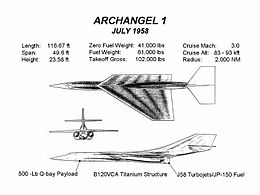
Airplane Picture: Archangel 1 design (July 1958)
By the autumn of 1957 so many ideas had been submitted that Bissell arranged for the formation of a new advisory committee to study the concepts, led by Edwin Land under the designation Project Gusto.[4] The committee first met in November to arrange for submissions. At their next meeting, on 23 July 1958, several submissions were studied.
Kelly Johnson of Lockheed presented the Archangel I design, which could cruise at Mach 3 for extended periods in order to take advantage of blip/scan spoofing, although it was not designed for reduced RCS. Convair proposed a parasite aircraft that was launched in the air from a newer version of the B-58 Hustler that was then being studied. The Navy introduced a submarine-launched inflatable rubber vehicle that would be lifted to altitude by a balloon, boosted to speed by rockets, and then cruise using ramjets. Johnson was asked to provide a second opinion on the Navy design, and the committee arranged to meet again shortly.
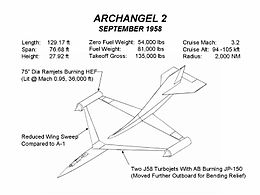
Airplane Picture: Archangel 2 design (September 1958)
At the next meeting, in September 1958, the designs had been further refined. Johnson reported on the Navy concept and demonstrated that it would require a balloon a mile wide for launching; the submission was then dropped. Boeing presented a new design for a 190-foot (58 m) long liquid hydrogen powered inflatable design. Lockheed presented several designs; the Lockheed CL-400 Suntan looked like a scaled-up F-104 Starfighter powered by wingtip-mounted hydrogen-burning engines, the G2A was a subsonic design with a low radar cross-section, and the A-2 was a delta wing design using zip fuel-powered ramjets. Convair entered their parasite design, slightly upgraded and now intended to fly at Mach 4.
FISH
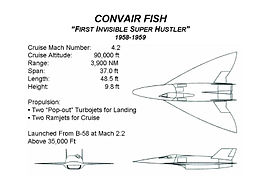
Airplane Picture: Fish design (1958/59)
Convair's parasite design was derived from the Super Hustler concept which Convair had proposed to the Air Force. The original version had been a two-part design, the rear portion being an unmanned booster powered by a pair of ramjets, and the front portion a manned aircraft with a single ramjet. The Super Hustler could either be launched from under a B-58 bomber or from a ground trailer using a booster rocket. For the air launch, the Super Hustler would be carried to a speed of Mach 2 at 35,000 ft (11,000 m), and released. All three ramjets would fire for "boost", after which the rear portion would fall away. The unmanned booster could also be used as a weapon, if armed.
For Project Gusto, the concept had been simplified and reduced to a single aircraft. Code-named FISH or First Invisible Super Hustler, the aircraft was based on a lifting body design that bears some resemblance to the Asset of a few years later. It differed in having the nose taper down to a flat horizontal line instead of the rounded delta of the ASSET, and the fuselage was not as large at the rear. Two vertical control surfaces were placed on either side of the fuselage at the rear, and a small delta wing covered about the rear third of the aircraft. It was to be powered by two Marquardt RJ-59 ramjets during the cruise phase, providing a cruise speed of Mach 4 at 75,000 ft (23,000 m), climbing to 90,000 ft (27,000 m) as it burned off fuel. In order to handle the intense heat generated by skin friction at these speeds, the leading edges of the nose and wings were built of a new "pyroceram" ceramic material, while the rest of the fuselage was made of a honeycomb stainless steel similar to the material for the proposed XB-70 Valkyrie. After completing its mission, the aircraft would return to friendly airspace, slow, and then open intakes for two small jet engines for the return flight at subsonic speeds.
Lockheed's entry had also changed during the research phase. Their original submission was the Archangel II (A-2), another ramjet-powered design, but one that was ground-launched using large jet engines.
The committee didn't find either entry particularly interesting, and when the B-58B was canceled by the Air Force in 1959, the entire "Fish" concept was put in jeopardy. There was some design work on converting the existing A-model Hustlers as "Fish" carriers, but the aircraft appeared to have limited capabilities for launching the "Fish", and the Air Force was unwilling to part with any of their bombers anyway. The committee asked both companies to return with another round of entries powered by the Pratt & Whitney J58 turboramjet.
Kingfish
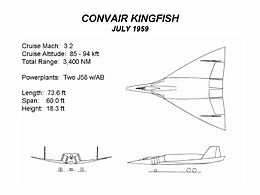
Airplane Picture: Kingfish design (July 1959)
After cancellation of the B-58B in mid-1959, Convair turned to a completely new design, similar to their earlier entry in name only. The new "Kingfish" design had much in common with the Convair F-106 Delta Dart, using a classic delta wing layout like most of Convair's products. It differed in having two of the J58 engines buried in the rear fuselage, and twin vertical surfaces at the rear. The intakes and exhausts were arranged to reduce radar cross section, and the entire aircraft had the same sort of angular appearance as the later Lockheed F-117. The leading edges of the wings and intakes continued to use pyroceram, while other portions used a variety of materials selected for low radar reflection, including fiberglass. The new engines reduced the cruise speed to Mach 3.2 compared to the "Fish"'s Mach 4.2, but range was increased to about 3,400 nm (6,300 km).
Airplane Picture: A-11 design (March 1959)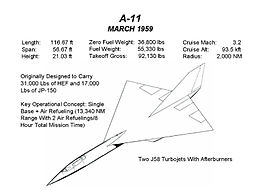
In August 1959 the teams met again to present their latest designs. Lockheed had produced an aircraft similar to the "Kingfish", the A-11, but it was more "conventional" in layout. Although the A-11 had somewhat better performance than "Kingfish", the panel generally preferred Convair's design due to its much lower RCS. Johnson expressed skepticism of Convair's claimed RCS, and complained that they had given up performance to achieve it: "Convair have promised reduced radar cross section on an airplane the size of A-12. They are doing this, in my view, with total disregard for aerodynamics, inlet and afterburner performance."
In the end it was not performance that decided the outcome; during the U-2 project Lockheed had proven its ability to design advanced aircraft in secret, on-time, and under-budget. In contrast, Convair had massive cost overruns with the B-58 and no secure facility similar to the Skunk Works. Lockheed promised to lower the RCS in a modified version of the A-11 known as the A-12, and that sealed the deal. The A-12 entered service with the CIA in the 1960s, and was slightly modified to become the Air Force's SR-71.
Aftermath
Some small-scale work on the "Kingfish" continued even after the choice of the A-12, in case the A-12 ran into problems. This did not occur, and the "Kingfish" funds soon disappeared.
The CIA continued studies into even higher performance aircraft, and studied replacing the A-12 under Project Isinglass. Isinglass focused on a new design blending features of the General Dynamics F-111 and "Kingfish", which became possible when General Dynamics moved Convair's work to their Fort Worth site. The new design aimed to produce a new reconnaissance aircraft capable of reaching up to Mach 5 at an altitude of 100,000 ft (30,000 m). The CIA felt that the extra performance would not be enough to protect it from missile systems already capable of attacking the A-12, and nothing came of the project
Ironically, the entire idea of spoofing radars through their blip/scan turned out to not work. It was soon discovered that the high-temperature exhaust was a fairly good radar reflector at certain wavelengths. Lockheed proposed adding cesium to the jet fuel to help mask this effect. Additionally, the entire idea relied on problems in the radar display systems, upgrades to these systems could render the entire concept moot. In the end, the A-12 was considered too vulnerable and was only flown over secondary nations like Vietnam. The failure of the A-12's attempts to avoid radar was proven when the Vietnamese proved able to track the A-12 with some ease, even firing on it on occasion and causing minor damage on one occasion in 1967.[5]
References Notes
1. ^ McIninch 1971, p. 2.
2. ^ Successor
3. ^ Successor
4. ^ Pedlow and Welzenbach 1992, p. 3.
5. ^ Pedlow and Welzenbach 1992
Bibliography
* McIninch, Thomas. "The Oxcart Story." Studies in Intelligence Issue 15, Winter 1971 (Released: 6 May 2007). Retrieved: 10 July 2009. * Merlin, Peter W. From Archangel to Senior Crown: Design and Development of the Blackbird. Reston, Virginia: American Institute of Aeronautics and Astronautics (AIAA), 2008. ISBN 978-1-56347-933-5. * Pedlow, Gregory W. and Donald E. Welzenbach. "Chapter 6: The U-2's Intended Successor: Project Oxcart, 1956-1968." The Central Intelligence Agency and Overhead Reconnaissance: The U-2 and OXCART Programs, 1954 - 1974. Washington, DC: Central Intelligence Agency, 1992. Retrieved: 2 April 2009. * Scott, Jeff. "Convair Super Hustler, Fish & Kingfish." Aerospaceweb Question of the Week, 31 December 2006. * Suhler, Paul A. From RAINBOW to GUSTO: Stealth and the Design of the Lockheed Blackbird. Reston, VA: American Institute of Aeronautics and Astronautics, 2009. ISBN 1-60086-712-X. * "Super Hustler: A New Approach to the Manned Strategic Bombing-Reconnaissance Problem." Convair, FMZ-1200-20, 26 May 1958. * "Super Hustler SRD-17: TAC Bomber Studies." Convair. FZM-1556B, 27 April 1960.
Living Warbirds: The best warbirds DVD series.
Source: WikiPedia